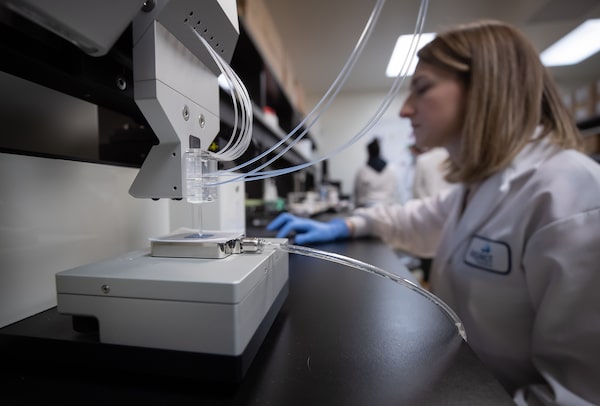
Erin Bedford, head of academic partnerships at Aspect Biosystems, uses a RX1 bioprinter to make a 3D tissue patch, in Vancouver, on October 8, 2021. The theory behind the technology is that once implanted into the body, the tissue patch can replace, repair or supplement impaired biological functions like insulin production in diabetes patients.DARRYL DYCK/The Globe and Mail
A University of British Columbia spinoff that 3-D prints live tissue implants intended to cure diabetes and liver ailments has struck a development deal with Danish drug giant Novo Nordisk AS NVO-N that could be worth more than US$2.6-billion.
The deal establishes 10-year-old Aspect Biosystems Ltd., with its Star Trek-like technology, as the newest star to emerge from British Columbia’s biotechnology sector. It’s also the latest Canadian startup, like fellow Vancouver startup AbCellera Biologics Inc. ABCL-Q, to combine a complex mix of cutting-edge technologies to develop novel treatments for human health problems.
“Our goal is to provide something much better than daily insulin injections,” Aspect’s 34-year-old chief executive officer Tamer Mohamed said in an interview, adding the technology has already cured rodents with Type 1 diabetes in preclinical testing. “We think there is a lot of room for improving that with a tissue designed to survive much longer in the body. This deal is transformative not just for our company but the space in general and hopefully for patients.”
Novo, one of three firms that dominates the global insulin market, will pay Aspect US$75-million upfront to fund research and development and take an undisclosed stake in the startup through a convertible note. Novo receives an exclusive, worldwide licence to use Aspect’s technology to develop up to four products to treat diabetes, obesity or both. Each program could deliver up to US$650-million apiece in development, regulatory, commercial and sales milestone payments to Aspect. It would also get royalties on any eventual product sales by Novo.
“We have looked at all the device companies out there; there are many,” said Jacob Sten Petersen, vice-president of Novo’s cell therapy division.
“We have found that Aspect is one of the more mature and interesting ones. The data they’ve generated looks very interesting,” he said, though neither Novo nor Aspect would share results from animal tests. “That’s what we need to scale up.”
Aspect was born about a decade ago. Mr. Mohamed and chief technology officer Simon Beyer were pursuing PhDs in the computer engineer lab of UBC professor Konrad Walus, a third co-founder.
Their goal was to develop technology that could create tissues, and they worked with a fourth co-founder, medical researcher Sam Wadsworth, now chief scientific officer. Encouraged by the university’s entrepreneurship program, the two PhD students dropped out to focus on building the company (the Egyptian-born Mr. Mohamed said his mother continues to badger him about when he will complete his studies).
They moved Aspect off campus in 2017 to continue building their technology. Aspect now employs more than 50 PhDs, and 80 people in total. It has raised US$50-million from investors and governments, including two venture capital deals led by Canadian firms Pangaea Ventures and Radical Ventures.
Aspect uses a combination of computational design and cellular and biomaterial processing to plot and produce implantable tissues. At its core it is a cell therapy developer, building its implants around stem cells or other cellular material that, once implanted into the body, can replace, repair or supplement impaired biological functions like insulin production in diabetes patients.
Using computer-aided design software, Aspect virtually plots out implants composed of living cells and tissue-like hydrogel polymers. The synthetic materials are designed to act as both a port to the body’s circulatory system and a shield for the embedded cells to protect against the immune system.
The polymers and tissues are then combined in an Aspect custom-designed 3-D printing machine that builds – in minutes – the tissue device in a sterile environment. It is implanted in an internal tissue layer of the abdomen called the omentum, where the circulatory system fuses into the device. Within minutes it becomes operational and starts to replace the impaired functions.
That is the theory, which Novo and Aspect will put through further animal and human safety and efficacy testing in the coming years, combining the Danish giant’s insulin-producing beta cells with Aspect’s technology. Aspect is also looking to separately advance other therapies to address liver ailments.
Novo has been exploring cell therapies for diabetes for nearly 20 years, stepping up efforts in 2019, expanding its cell therapies research and development division to 260 people and striking partnerships with several companies.
The endeavour has an added personal importance for Mr. Petersen: His 10-year-old daughter has Type 1 diabetes and needs multiple insulin injections a day.
“I can tell you it’s many decisions every day, it’s a big burden,” he said.
“There is a big medical need for people to have normal lives who live with Type 1 diabetes. That’s why we are doing cell therapies: To provide a curative treatment so people don’t have to think about being sick many times a day and night. How you then transform part of the medical system to cope” with a surge in surgical procedures to implant cell therapy devices, if they prove to work, “is something we and our competitors will do together,” he said.
 Sean Silcoff
Sean Silcoff